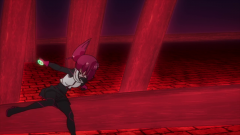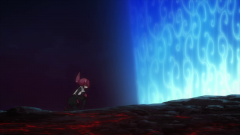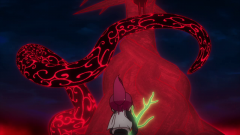And so Kemurikusa comes to a fitting end, one that never surpassed its peak that was episode 11, but it’s a decent one to close off this series. Kemurikusa is an adventure show at heart, so it’s always more about the journey than the destination. They go for hopeful route here, as Wakaba and Rin reach the natural world, as opposed to their destructive world. Frankly though, I regard it as the least favorite part of the episode, it feels more as a wish-fulfilling part where they all reach happy ending: the perfect place to stay free of red bugs, all the girls somehow make it alive (despite several heartfelt goodbyes) and Rin expresses her love for Wakaba. About the last part, while it sounds corny on paper, it actually has some deeper layers. Rin embodies the original leaf of The First Person, and the First Person herself is pretty much in love with Wakaba. She’s the one who erased her own mission of saving Wakaba once she learns that he’s consumed by the red fog. That makes it quite a tragic story of splitting herself up for no purpose at all.
At the same time, the whole point of this journey, internally, is for Rin to realize her feeling with Wakaba. While I could argue that having Wakaba stabbed (and then miraculously rescued later on) just to bring Rin’s emotion out is a bit calculated, I don’t really mind it personally. As soon as she speaks out her heart, the lost sisters appeared to save the day. These girls have a strong presence throughout the show despite their limited screen time that I’m more than happy to see they come back and kick some ass. There’s still some slightly loose threads that I want to know more. For example, Wakaba’s origin and more about the Sisters’ death circumstances, but at the same time I’m pleased with the amount of world-building Kemurikusa has put in. The intriguing of this apocalyptic universe is certainly Kemurikusa’s biggest assets.
As a whole, I don’t regret blogging this show. The visual elements remain the show’s biggest love-it or hate-it. I think the detractors have their valid arguments when they point out the show’s “unpolished” look. For me though, it has become TATSUMI’s signature style, one that remains unique in this medium. To add to that, the show has a strong grip on its color palette and the sound designs. Full review will come shortly.





I don’t think there’s any loose thread, the ending is quite perfect as it is. Rin and the first person said they were in a ship, but from the layout o the islands and the imagery we’ve seen, I think they were more in a kind of a museum cum large theme park, especially with the shots of the roller-coaster, ticket office etc., early on in the series. This is supported in ep 11, when it was said that Wakaba is a researcher that was brought in to do the work in the museum because of his special skills. Thus, we can surmise from ep 11 that the museum is an enclosed space, not in an apocalyptic world, but in a future earth that is still populated with people. The biggest gripe I have is that the budget for this show must not be very high, thus the unpolished look . But the story-telling and world-building is top notch, and that in my book is what it all matters.